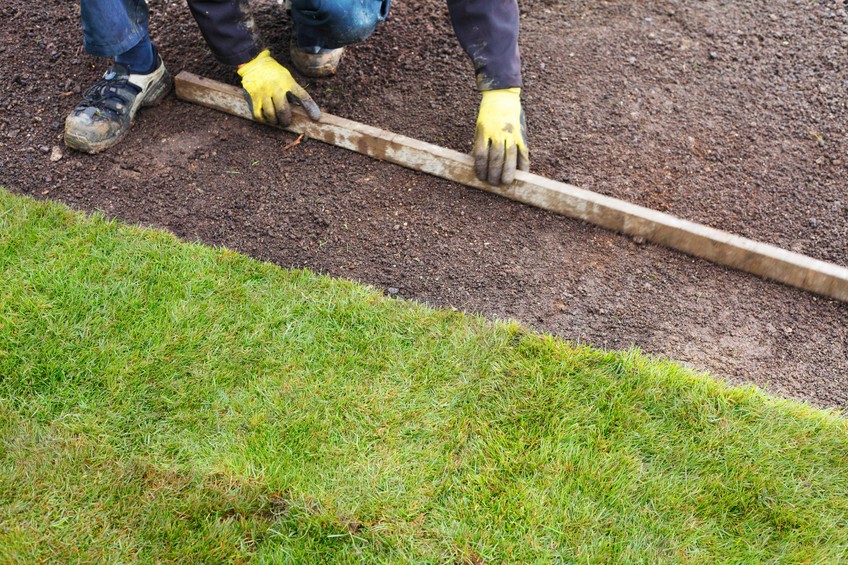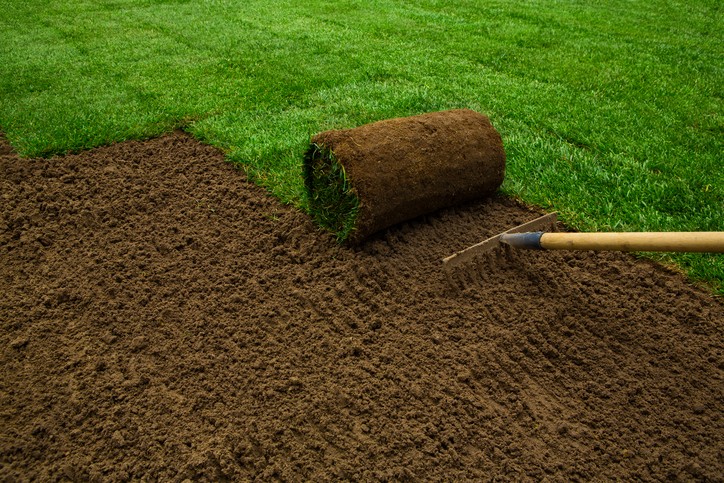
Contents
- 1 Prepare soil
- 2 Working in soil activator
- 3 Leveling the seeding area and letting the soil rest
- 4 Leveling the seeding area
- 5 Prepare seedbed for sowing lawn
- 6 Sowing seed and distributing it optimally
- 7 Work the seed into the soil after sowing the lawn.
- 8 Consolidate lawn surface
- 9 Lawn care in the 1st month
- 10 lawn cut
- 11 Tips and tricks for laying and sowing lawn
- 12 Author
Prepare soil
01 Before sowing, you need to deeply loosen the soil with a spade or digging fork, at least 15 cm or a spade blade deep. You can also dig deeper, it will not hurt. If you need to work large areas, it is best to do so with a garden tiller or power hoe. Then remove root debris, stones and weeds.
Working in soil activator
02 Work a soil activator into the prepared soil with a garden hoe to a depth of about 5 cm. Such an activator improves the structure of the soil permanently because it supports the soil organisms.
If the soil is very sandy or has been used intensively and no new soil has been added, you can apply a lawn starter fertilizer at the same time.
Leveling the seeding area and letting the soil rest
03 After you have prepared the soil, the seeding area is roughly leveled. After such a deep loosening, the soil needs time to settle. Let it rest for at least 2 days, possibly a little longer depending on the soil type. To speed up the process, you can gently compact the dry soil with a lawn roller.
Leveling the seeding area

04 When the soil has settled, you can level the seeding area. You can also use a lawn roller for this purpose.
Prepare seedbed for sowing lawn
05 Now prepare the seedbed for the future lawn. To do this, remove weeds, roots, stones and coarse clods from the upper 3 cm with a rake; then finely level the sowing area with a rake. Make sure that the soil is 0.5 to 1 cm below the top edge of the lawn, i.e. the future mowing edge.
Sowing seed and distributing it optimally
06 It is very important to distribute the seed evenly so that the lawn grasses can flourish optimally. It is not so easy to do this by hand, so we recommend a spreader for this job. Drive the spreader only in longitudinal or transverse direction; this way the seed can be distributed evenly. Please refer to the seed packaging for the amount of seed per square meter.
Work the seed into the soil after sowing the lawn.
07 To be on the safe side, you can work the lawn seeds into the soil very lightly with a rake. In this way, the seeds are guaranteed to have contact with the soil and are protected from drying out. This is especially recommended when sowing in spring. This is not necessary with coated seeds.
Caution: Lawn seeds are light germinators. Therefore, they must be worked into the soil only very lightly!
Consolidate lawn surface
08 The lawn is then carefully treaded with wooden boards or gently rolled with a lawn roller.
Lawn care in the 1st month
09 Now water the lawn carefully with a garden sprayer or sprinkler. The seeds and also the already germinated lawn plants must not dry out under any circumstances and should be watered several times a day, depending on the weather.
Continuous watering is essential during the first 3 to 4 weeks!
Tip: With a lawn sprinkler connected to a watering computer, you have less effort and risk.
lawn cut
10 After about 1 month, or when the new lawn is about 7 to 8 inches tall, it will tolerate its first cut. This first cut contributes decisively to a closed turf.
Especially in the beginning, observe the so-called rule of thirds: The lawn should be cut by a maximum of 1/3 of its height when mowing. Therefore, adjust your lawn mower accordingly.
Now you can strengthen the young grasses with long-term lawn fertilizer.
Tips and tricks for laying and sowing lawn
Choose lawn seed carefully: While any lawn mix looks nice at first, time separates the wheat from the chaff. Therefore, it is better to use high-quality grass seed for your grasses right away! Also, consider the stresses your lawn will have to withstand and the location where it will grow. This is important because if, for example, you do not sow a shade lawn in damp, dark corners, in the worst case nothing will happen except moss.
- When is the best time to plant a lawn: It is best to sow your lawn seed in spring or autumn. Autumn has the advantage that the newly sown lawn can grow in peace over the winter and does not dry out or become heavily stressed.
- What soil is suitable for planting lawn:
- Grasses love a loose, well-aerated soil. This allows them to grow roots quickly and easily, and gives them access to water and important nutrients. Sandy loam soil is ideal for this.
- Improve poor soils before sowing: Improve heavy, loamy soils with lawn sand (approx. 1.5-3 kg sand/m 2). In very sandy soils, you can work lawn soil or peat about 15 cm deep into the soil.
- If topsoil is missing, for example after construction work, then apply a layer of garden or lawn soil about 15 cm high. You can also level out unevenness in this way.
- Test the soil: Don’t just lime it. Test the pH value of the soil beforehand with a test kit. If the soil is too acidic (pH below 5.5), apply lime to the lawn before planting.
- Plan lawn watering and maintenance early: Think about how you want to water the lawn from the beginning. You need to plan for automatic watering early, because the necessary piping and sprinklers need to be dug in before seeding. Likewise, the increasingly popular robotic mower needs a boundary wire to prevent it from mowing down vegetables and flowers.
- Don’t establish a lawn until after the house is built: New house, new lawn. Logical. But don’t start until all the other work on and in the house has been completed. If workmen, movers or heavy vehicles have to drive over the new lawn, it will soon no longer look fresh. Also make sure that no construction debris remains in the soil under the future lawn.
- Do not scarify too early: Do not scarify for at least 1 year after seeding, as there is a risk of uprooting the young lawn grasses.
- What does it cost to re-seed your lawn: Self-seeding is a bit of a hassle, but it’s cheaper than sod and not witchcraft at all. Of course, if you want to have a beautiful lawn quickly, you can install sod when you re-seed your lawn.

